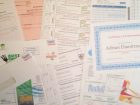
Insource reached an agreement to distribute and service the X1 Series in Ontario, Montreal and Western Canada approximately one year ago, its first agreement with RISO, and the company has already installed more than 20 systems primarily in the Greater Toronto Area. “In Canada we were doing so-so and along came Insource and just blew it out of the water,” says D’Urbano, noting Insource immediately committed to the product line and now has six technicians trained on the systems. “They increased our sales in the GTA and in Canada by some 400 percent in the past year – specifically with the X1.”
The RISO ComColor X1 9150 is a unique cut-sheet colour inkjet system that prints at speeds of up to 150 pages per minute in simplex or 75 pages duplex. D’Urbano explains the X1 Series, which also includes a model that prints at 120 simplex pages per minute, fits a production niche between offset presses and toner presses, while also costing just a fraction of roll-fed inkjet presses, which typically fit a price range of $1.5 to $2.5 million.
The X1 Series systems range in price from approximately $30,000 to $50,000 and, in addition to providing variable imaging not available with offset, present a significantly lower cost per page relative to toner presses when adding colour to transactional documents or envelopes. “If you have the audacity to add four digits in colour [on a toner press] it will cost you around six cents, so you often sacrifice colour and print it in black,” says D’Urbano. “This is not the case with inkjet. It can be printed for the same cost [as monochrome] at about a penny a page on a RISO – you are not being penalized for adding colour.”
D’Urbano continues to break down the cost-per-page benefits of the RISO X1 systems, explaining there is only one fixed cost via the service agreement, which amounts to about half a cent. He explains an envelope produced on the X1 will have a total job cost of around 1.5 cents, meaning the balance – about a penny per page – is the ink cost regardless if applying colour or monochrome.
A new CMYK ink set inside an X1 system, which is about $2,000 worth of ink, will produce around 100,000 copies, explains D’Urbano, which equates to about two cents per copy based on five percent coverage across the board. The X1 9150 is rated to produce 500,000 copies per month.
D’Urbano explains the low operating cost of the X1 equates to high profit when considering, for example, envelopes printed with a return address and logo in the Toronto market typically sell for about 25 cents each. “If you were to add some variable data, you can sell that for around 40 cents. If you have customers who want to promote events, there is no reason why you cannot use the white space on the envelope, which is hugely popular in the U.S., and that sells for about 45 to 50 cents on a technology where the operating cost is about a penny and a half. That is $15 per thousand – extremely profitable.”
Unlike a dedicated envelope-printing system, D’Urbano explains the RISO X1 series also provides flexibility with the ability to run cut-sheet applications like Tyvek, books and forms – the latter of which is well suited for numbering with the X1. Producing up to 9,000 impressions per hour, the X1 can be fitted with folder inserters, as well as a perfect-binding system that produces up to 300-page books. These applications are supported by another inkjet advantage over toner in that the X1 does not produce heat so that sheets can be printed flat at high speeds.
Suzanne Wakefield, Managing Partner of Insource, points out that the X1 is not a replacement system for high-end toner presses, and certainly not for sheetfed offset, which both fit tried and true high-quality print applications. “We have some large printers who are using it when they have to do reprints,” she says, “rather than doing an entire reset of the job. We often sell it as a complimentary piece.”
D’Urbano explains the X1 Series, which is currently grabbing the attention of central reprographic departments, can also be leveraged for higher-end work, but this requires the use of coated inkjet papers to produce toner-like images. Such papers may cost four or five cents per sheet, which ultimately equates to a toner per colour page cost, when the RISO operating cost of a penny and a half is added. The flexibility of the X1 Series, however, does provide the opportunity to produce such work for niche short-run applications.
“This product provides a lot of solutions for different problems,” says Suzanne Wakefield, “because you can go into a variety of situations and RISO can still be the answer, even if it is a different problem from printer to printer that we are solving.”
Print this page

